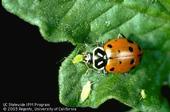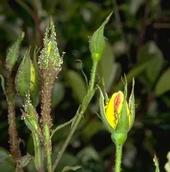![Sticky honeydew and whitish hackberry aphids on hackberry leaves. [J.K.Clark]](https://ucanr.edu/blogs/UCIPMurbanpests/blogfiles/32788small.jpg)
If your neighborhood has Chinese hackberry trees, chances are you've noticed a sticky substance on cars, parking lots and sidewalks. The sticky substance is called honeydew, and might be caused by a pest called the hackberry woolly aphid.
Hackberry woolly aphids appear as fuzzy, bluish white masses on leaves and other tree parts and are about 1/10 of an inch or less in diameter. Not all the aphids have wings, but those that do have distinct black borders along the forewing veins and their antennae have alternating dark and light bands. As the aphids suck out plant juices, they excrete the sticky honeydew. Sometimes blackish sooty mold grows on the honeydew and creates a sticky mess on leaves and surfaces beneath infested...
![Whitish wax and sticky honeydew from Asian woolly hackberry aphid on hackberry leaves. [Photo by J.K. Clark]](https://ucanr.edu/blogs/UCIPMurbanpests/blogfiles/24066small.jpg)
The hackberry woolly aphid (Shivaphis celti), sometimes called Asian woolly hackberry aphid, infests the widely planted Chinese hackberry (Celtis sinensis) and other Celtis species. Often, the first observed sign of a hackberry woolly aphid infestation is the sticky honeydew it produces, upon which blackish sooty mold grows, creating a sticky mess on leaves and surfaces beneath infested trees.
These aphids also secrete pale wax, which covers their bodies. Woolly aphids on shoot terminals and leaves appear as fuzzy, bluish or white masses, each about 1/10 inch or less in diameter. Winged forms have distinct black borders along the forewing veins and their antennae have alternating dark and light...
- Author: Mary Louise Flint

Many retail nurseries and garden centers sell lady beetles for controlling aphids in gardens and landscapes. Gardeners often ask, “Does releasing lady beetles really work?”
University of California research has demonstrated that lady beetle releases can effectively control aphids in a limited landscape or garden area if properly handled and applied in sufficient numbers. However, because of inadequate release rates or poor quality, lady beetles often fail to provide satisfactory control; other low toxicity aphid management practices such as hosing off or insecticidal soap or oil sprays may be more effective. Here are some things to consider if you decide to try lady beetle releases:
Lady beetles...

The recent warm spring weather has stimulated aphid outbreaks in many landscapes and gardens. Two short YouTube videos from the University of California Statewide IPM Program show how to battle these pests without pesticides.
Hosing Off Aphids demonstrates techniques for knocking off aphids with water.
In Aphid-eating Insects in Action see lady beetles, syrphid flies, lacewings and other "natural enemies" hunting and gobbling up aphids.
UC IPM provides much more aphid management and identification information on its web pages at


